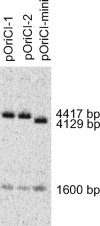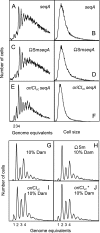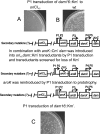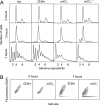Replication of Vibrio cholerae chromosome I in Escherichia coli: dependence on dam methylation
- PMID: 20511501
- PMCID: PMC2916376
- DOI: 10.1128/JB.00311-10
Replication of Vibrio cholerae chromosome I in Escherichia coli: dependence on dam methylation
Abstract
We successfully substituted Escherichia coli's origin of replication oriC with the origin region of Vibrio cholerae chromosome I (oriCI(Vc)). Replication from oriCI(Vc) initiated at a similar or slightly reduced cell mass compared to that of normal E. coli oriC. With respect to sequestration-dependent synchrony of initiation and stimulation of initiation by the loss of Hda activity, replication initiation from oriC and oriCI(Vc) were similar. Since Hda is involved in the conversion of DnaA(ATP) (DnaA bound to ATP) to DnaA(ADP) (DnaA bound to ADP), this indicates that DnaA associated with ATP is limiting for V. cholerae chromosome I replication, which similar to what is observed for E. coli. No hda homologue has been identified in V. cholerae yet. In V. cholerae, dam is essential for viability, whereas in E. coli, dam mutants are viable. Replacement of E. coli oriC with oriCI(Vc) allowed us to specifically address the role of the Dam methyltransferase and SeqA in replication initiation from oriCI(Vc). We show that when E. coli's origin of replication is substituted by oriCI(Vc), dam, but not seqA, becomes important for growth, arguing that Dam methylation exerts a critical function at the origin of replication itself. We propose that Dam methylation promotes DnaA-assisted successful duplex opening and replisome assembly at oriCI(Vc) in E. coli. In this model, methylation at oriCI(Vc) would ease DNA melting. This is supported by the fact that the requirement for dam can be alleviated by increasing negative supercoiling of the chromosome through oversupply of the DNA gyrase or loss of SeqA activity.
Figures









Similar articles
-
Distinct replication requirements for the two Vibrio cholerae chromosomes.Cell. 2003 Aug 22;114(4):521-30. doi: 10.1016/s0092-8674(03)00611-1. Cell. 2003. PMID: 12941279
-
Overinitiation of chromosome replication in the Escherichia coli dnaAcos mutant depends on activation of oriC function by the dam gene product.Mol Microbiol. 1997 Aug;25(4):661-70. doi: 10.1046/j.1365-2958.1997.5001872.x. Mol Microbiol. 1997. PMID: 9379896
-
DNA sequestration and transcription in the oriC region of Escherichia coli.Mol Microbiol. 1997 Dec;26(5):889-96. doi: 10.1046/j.1365-2958.1997.6221989.x. Mol Microbiol. 1997. PMID: 9426127
-
Initiation of DNA Replication at the Chromosomal Origin of E. coli, oriC.Adv Exp Med Biol. 2017;1042:79-98. doi: 10.1007/978-981-10-6955-0_4. Adv Exp Med Biol. 2017. PMID: 29357054 Review.
-
IHF and Fis as Escherichia coli Cell Cycle Regulators: Activation of the Replication Origin oriC and the Regulatory Cycle of the DnaA Initiator.Int J Mol Sci. 2023 Jul 18;24(14):11572. doi: 10.3390/ijms241411572. Int J Mol Sci. 2023. PMID: 37511331 Free PMC article. Review.
Cited by
-
The replication enhancer crtS depends on transcription factor Lrp for modulating binding of initiator RctB to ori2 of Vibrio cholerae.Nucleic Acids Res. 2024 Jan 25;52(2):708-723. doi: 10.1093/nar/gkad1111. Nucleic Acids Res. 2024. PMID: 38000366 Free PMC article.
-
Functionality of Two Origins of Replication in Vibrio cholerae Strains With a Single Chromosome.Front Microbiol. 2018 Nov 30;9:2932. doi: 10.3389/fmicb.2018.02932. eCollection 2018. Front Microbiol. 2018. PMID: 30559732 Free PMC article.
-
Replicate Once Per Cell Cycle: Replication Control of Secondary Chromosomes.Front Microbiol. 2018 Aug 7;9:1833. doi: 10.3389/fmicb.2018.01833. eCollection 2018. Front Microbiol. 2018. PMID: 30131796 Free PMC article. Review.
-
Cell cycle-coordinated maintenance of the Vibrio bipartite genome.EcoSal Plus. 2023 Dec 12;11(1):eesp00082022. doi: 10.1128/ecosalplus.esp-0008-2022. Epub 2023 Nov 22. EcoSal Plus. 2023. PMID: 38277776 Free PMC article. Review.
-
DNA methylation by CcrM activates the transcription of two genes required for the division of Caulobacter crescentus.Mol Microbiol. 2013 Apr;88(1):203-18. doi: 10.1111/mmi.12180. Epub 2013 Mar 11. Mol Microbiol. 2013. PMID: 23480529 Free PMC article.
References
-
- Adamcik, J., V. Viglasky, F. Valle, M. Antalik, D. Podhradsky, and G. Dietler. 2002. Effect of bacteria growth temperature on the distribution of supercoiled DNA and its thermal stability. Electrophoresis 23:3300-3309. - PubMed
-
- Adhya, S., and M. Gottesman. 1982. Promoter occlusion: transcription through a promoter may inhibit its activity. Cell 29:939-944. - PubMed
Publication types
MeSH terms
Substances
LinkOut - more resources
Full Text Sources

